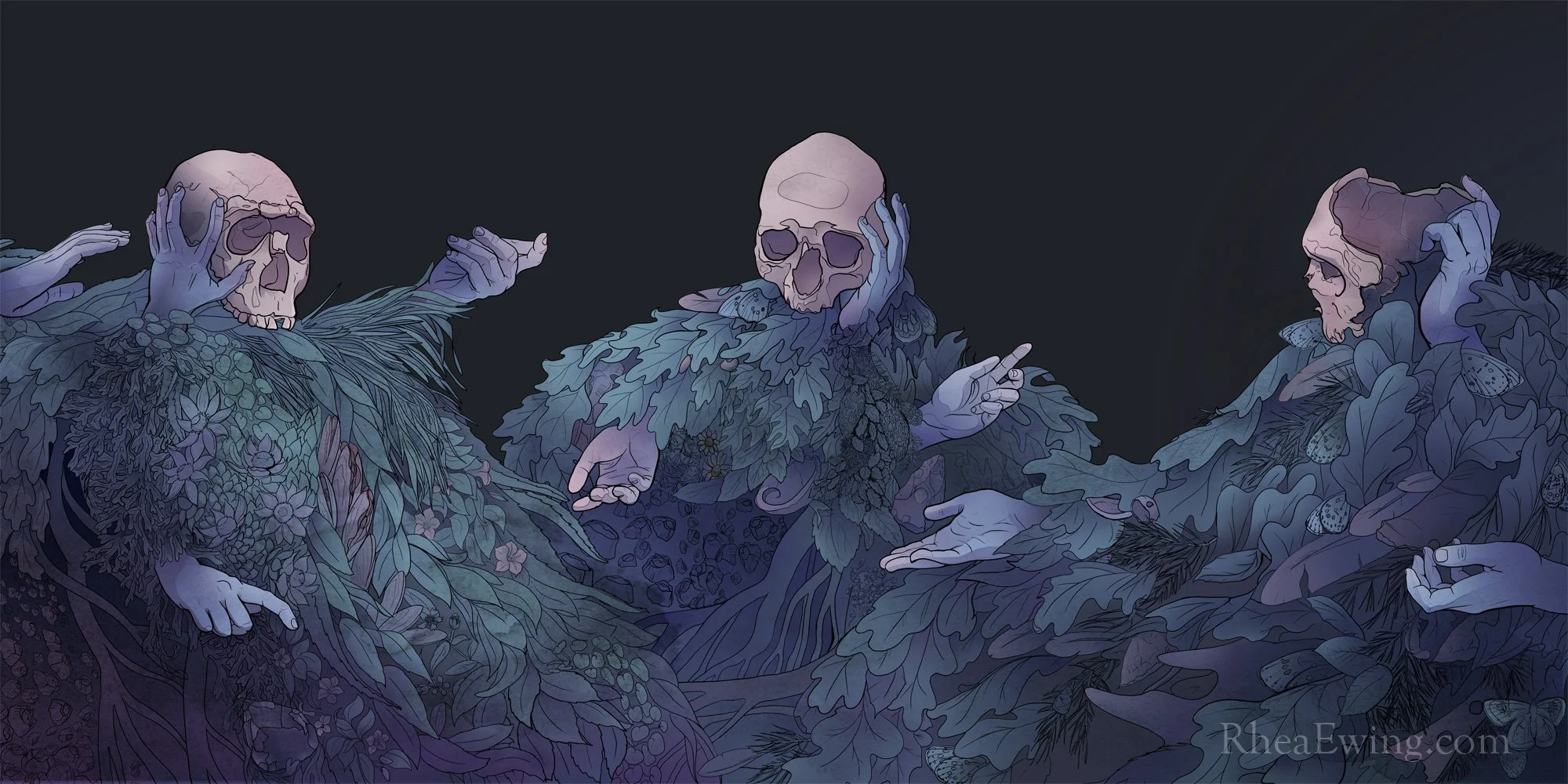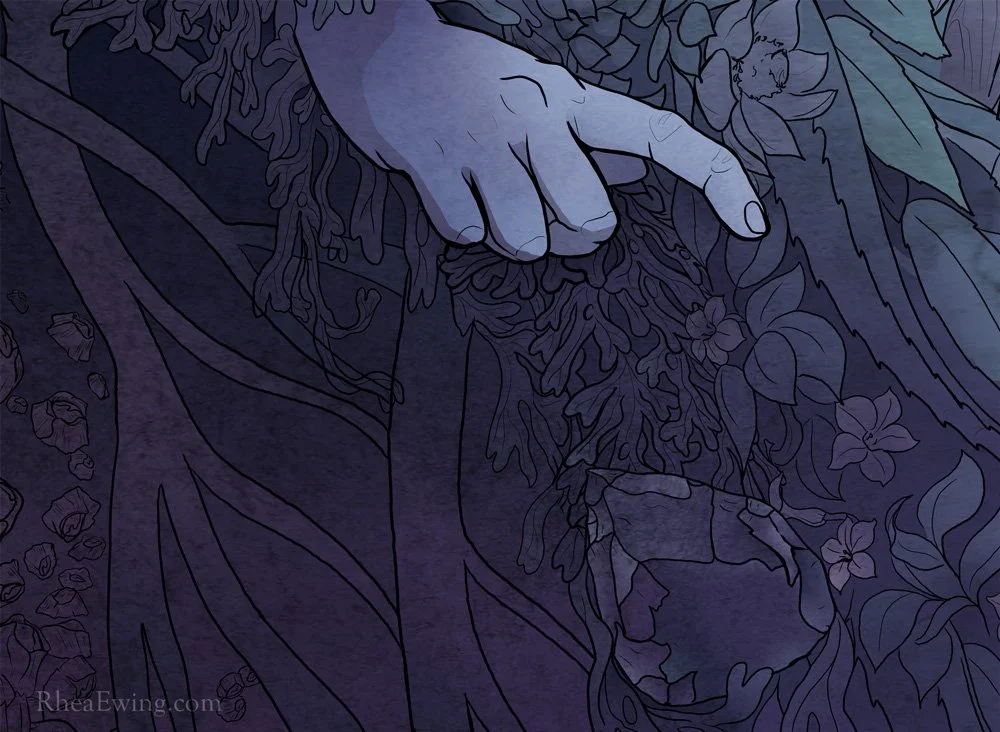Ancestor Series
Collaborations
glicée, acrylic, and papercut
72"X36" 2016
original available for purchase
Homo ergaster:
Ergaster lived between 1.4 and 1.9 million years ago. Ergaster used a more complex toolset than H. habilis and may have been the first hominin to harness fire.
Homo sapiens:
This particular fossil was found in Brazil and likely belonged to a young woman who lived 11,500 years ago. Scientists have named her Luzia, a reference to the famous Lucy find. The discovery led to a more nuanced understanding of diversity in Paleoamericans.
Homo neanderthalensis:
This skull was found in a quarry in 1848, before the “official” discovery of Neanderthals. Since no one knew what it was, the skull was placed in a cupboard and forgotten about for years.
These specific individuals would never have interacted. The figures are instead placed in a larger context, the influence of their species and individual fossil finds radiating out across thousands of years as part of a larger conversation. This piece depicts the complex interaction of knowledge, culture, social structures, genetic material, and tools: a conversation that we continue to this day.
Ancestor Series
Can I See You?
glicée, acrylic, and papercut
48"X48" 2016
original sold to private collector
Anatomically modern human, dated to ~21,000 BCE. Found in Italy.
Two human fossils were found in Italy at the start of the 20th century. The fossils were the subject of some rather dubious claims regarding race and human evolution, fueled by the results of facial reconstruction work done by the scientists involved. Presumably to repair some damage from the topsoil above, one of the skulls was given extensive reconstruction and modification of the jaw. This was the skull of a young man whose wisdom teeth had not grown in yet. The wisdom teeth were drilled out of the skull and the jaw was then artificially extended to accommodate the extra teeth. The resulting protruding teeth were then declared as matching “negroid” features, a fact used by some to further their own horrifically racist agendas.
Mammoth ivory carving, dated to ~23,000 BCE. 3.65 cm high. Found in a cave near Brassempouy, France.
This statuette is the earliest known carving of a realistic human face. This figure is sometimes called the “Venus of Brassempouy”, or “Woman with the Hood”, though many have noted it could also be a depiction of hair or a wig.
Scholar Randal White noted in his essay The Women of Brassempouy: “The figurines emerged from the ground into a colonial intellectual and socio-political context nearly obsessed with matters of race.”
Speculations about the race of the figure (and the race of the carver) began shortly after the figure’s discovery in 1892. The racial interpretations of the find varied depending on where the object was viewed. White Americans were against the idea that their human ancestors could be seen as black, and interpreted the figure as white. Meanwhile, white Europeans were keen to see Africa’s people as a less evolved ancestor to their own “superior” race, and therefore interpreted the figure as black.
White writes: “It probably served French colonial purposes to see African peoples as evolutionary holdovers, as much as it served American interests to see Africans as a non-ancestral side branch leading to a manifest destiny of extinction.”
The co-option of human fossil finds towards racist agendas continues to this day. When developing each of the Ancestors images, I would do a quick Google image search to find pictures to use as drawing reference. Each page of search results was a minefield, full of white supremacist blogs and forums, each regurgitating the rhetoric of 20th century paleoanthropologists to justify their biases, mostly against black and middle eastern people.
Ancestor Series
Steinheim
glicée, acrylic, papercut
36"X48" 2016
original sold to private collector
Homo heidelbergensis skull, dated to 250,000–350,000 BCE. Found near Steinheim an der Murr, Germany.
This individual lived with a slow-growing brain tumor. The tumor would potentially have caused chronic headaches, seizures, personality changes, and visual hallucinations while the individual was alive… or perhaps no symptoms at all. Still, it serves as a reminder that the story of human evolution is also the story of our relationship with chronic pain and mental illness.
Ancestor Series
Justified Bodies
glicée, acrylic, pencil, and papercut
36"X24" 2016
original available for purchase
Paleolithic carvings of female figures have been the center of much heated discussion. These figures in particular have been the focus of a great deal of speculation and scrutiny. Fantasies and interpretations about them run the full gamut from empowering to humiliating. The central figure was the subject of a decades-long debate about its intended sex: whether it was male, female, or intentionally ambiguous. The figure is currently classified as female with an exaggerated labia majora. The figures on either side have been interpreted by some as cartoonishly exaggerated female forms, used either for fertility worship or simply as pornography. Others have interpreted the figures realistically, as anything from self-portraits to subjugating depictions of another race.
Regardless of their original intent, it is not difficult to see that the features that make these figures controversial are features held by real bodies today, which are similarly scrutinized for acceptability and asked to justify themselves: fat bodies, female bodies, and bodies whose sex or gender is seen as ambiguous. What is seen as questionable and what is immediately accepted by our current society shape our interpretations of the past.
Objects not to scale. From left to right:
Limestone carving dyed with red ochre, dated to 28,000-24,000 BCE. 11.1 cm high. Found near Willendorf, Austria.
Mammoth ivory carving, dated to ~23,000 BCE. 6.8 cm high. Found in a cave near Brassempouy, France.
Mammoth ivory carving, dated to 33,000-38,000 BCE. 6 cm high. Found near Schelklingen, Germany.


















